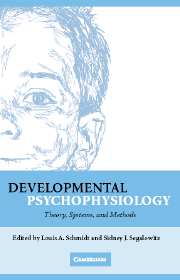Book contents
- Frontmatter
- Contents
- Foreword by Stephen W. Porges
- Preface
- Acknowledgments
- Contributors
- 1 Capturing the Dynamic Endophenotype: A Developmental Psychophysiological Manifesto
- SECTION ONE CENTRAL SYSTEM: THEORY, METHODS, AND MEASURES
- SECTION TWO AUTONOMIC AND PERIPHERAL SYSTEMS: THEORY, METHODS, AND MEASURES
- SECTION THREE NEUROENDOCRINE SYSTEM: THEORY, METHODS, AND MEASURES
- SECTION FOUR DATA ACQUISITION, REDUCTION, ANALYSIS, AND INTERPRETATION: CONSIDERATIONS AND CAVEATS
- 13 Psychophysiology Principles, Pointers, and Pitfalls
- 14 Obtaining Reliable Psychophysiological Data with Child Participants: Methodological Considerations
- Index
- References
13 - Psychophysiology Principles, Pointers, and Pitfalls
from SECTION FOUR - DATA ACQUISITION, REDUCTION, ANALYSIS, AND INTERPRETATION: CONSIDERATIONS AND CAVEATS
Published online by Cambridge University Press: 27 July 2009
- Frontmatter
- Contents
- Foreword by Stephen W. Porges
- Preface
- Acknowledgments
- Contributors
- 1 Capturing the Dynamic Endophenotype: A Developmental Psychophysiological Manifesto
- SECTION ONE CENTRAL SYSTEM: THEORY, METHODS, AND MEASURES
- SECTION TWO AUTONOMIC AND PERIPHERAL SYSTEMS: THEORY, METHODS, AND MEASURES
- SECTION THREE NEUROENDOCRINE SYSTEM: THEORY, METHODS, AND MEASURES
- SECTION FOUR DATA ACQUISITION, REDUCTION, ANALYSIS, AND INTERPRETATION: CONSIDERATIONS AND CAVEATS
- 13 Psychophysiology Principles, Pointers, and Pitfalls
- 14 Obtaining Reliable Psychophysiological Data with Child Participants: Methodological Considerations
- Index
- References
Summary
INTRODUCTION
Psychophysiology focuses on physiological processes associated with human sensory, motor, cognitive, emotional, and social functions. Developmental psychophysiology centers on the emergence of such processes in youngsters. Over the past several decades, technological advances have revolutionized the field. Marked progress has been made in psychology and neuroscience as well as in electrical engineering and applied mathematics. Advances in circuit boards and silicon chips have facilitated manufacturing of accurate, stable, and predictable devices for amplifying and filtering analog physiological signals, converting them to a digital format, and recording sizable datasets on personal computers. In addition, the computational efficiency and storage capacity of digital hardware have increased significantly, and software tools for signal processing have grown more sophisticated and widely available. Such technological advances have created a trend toward increased performance for a given price, and complete commercial laboratory systems have made human psychophysiology measures increasingly accessible to more investigators conducting basic and applied research.
As psychophysiology tools become widely available, needs increase for introductory tutorials for conducting psychophysiology assessments. Despite the ease of obtaining turn-key equipment and recording physiological data, fundamental challenges remain inherent to the work. For instance, most psychophysiological measures have multiple determinants. Bioelectric signals are often a composite of multiple physiological processes that co-occur or interact. For example, brain recordings contain ocular and muscle activity, and voluntary breathing influences heart rate variability. In addition, noise sources can mimic physiological processes, such as the AC power frequency overlapping with physiological activity and body movements confounding skin conductance responses.
- Type
- Chapter
- Information
- Developmental PsychophysiologyTheory, Systems, and Methods, pp. 367 - 423Publisher: Cambridge University PressPrint publication year: 2007
References
- 2
- Cited by



